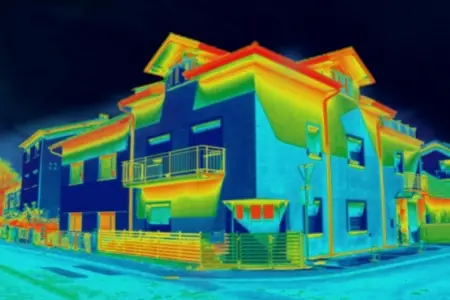Heat energy is also known as thermal energy. The largest source of thermal energy to the earth is the sun. Almost all life on earth depends on energy from the sun, which reaches us in a vast spectrum of wavelengths – gamma and x-rays (which are highly dangerous), UV rays, visible rays, infrared, radio and microwave.

The absorption or interaction of UV radiation with the matter on earth gives rise to solar thermal energy. Undoubtedly, areas or regions with minimal experience of sunshine experience cold weather, compared to equatorial regions of the earth, where there is a maximum amount of sunshine, and the temperature is very high.
The sun is not the only source of thermal (heat) energy, other sources include geothermal energy, electric energy, nuclear energy etc. Heat energy has many applications such as for cooking, used in a steam turbine, sundry work. Heat energy can be transferred via conduction, radiation and convection.
Flow Of Heat Energy
Heat energy refers to the transfer of energy flow from a hotter body to a relatively cooler body as a result of temperature difference. If two bodies of temperature differences are placed together, there will be a transfer of heat energy from the hotter body to the cooler body. Energy is expressed in terms of Joules. Do not confuse heat with temperature as they are two different things.

Heat energy has different sources which include electric heating of a conductor, combustion of biofuels, geothermal sources, electric arc and nuclear reactions.
There is a natural flow of heat from one hot body to a relatively cooler body when there is enough contact with each other. This flow of heat proceeds automatically until thermal equilibrium is achieved. If there’s no loss of heat to the environment, the temperature rise of a body is proportional to the amount of heat taken in by the body and the type of substance.
Transfer Of Heat
Heat transfer from a hot zone to a relatively cooler zone takes place in three ways, namely: Conduction, Convection and Radiation.
1. Conduction of heat: This happens when heat passes via a solid material from one end to another end, without an actual translational motion of the atoms.
When a metallic rod is heated, the kinetic energy of the metal atoms increases. Conductors of heat are materials that easily allow the transfer of heat through them. Insulators do not easily allow the passage of heat. All metals are examples of heat conductors while examples of insulators include wood, water, rubber etc.
2. Convection of heat: This refers to the transfer of heat in a liquid or gas by the movement of molecules from hotter to cooler zones. Convection remains the only method of transfer of heat in fluids. When a part of a fluid is heated, the atoms absorbing the heat gets hotter and lighter, with increased kinetic energy.
The hot particles move from a hot region to a cooler region. Automatically, the cooler, heavier particles fall into place to replace the escaping hot particles. This cycle continues until the entire liquid gets evenly heated.
3. Radiation of heat: Waves of heat can be transmitted through a vacuum by the action of radiation. UV ray is the radiant energy from the sun which causes heat sensation.
Heat transfer by radiation does not require any medium, unlike conduction and convection. Objects which are hot gives off heat energy which may be transferred to nearby regions by radiation. On a general note, rough black surfaces absorb and radiate heat quicker than polished white surfaces.
Where heat escapes from our homes
If there is cold and you notice too much winter air getting into your house, then it’s time to look at some possible places of heat loss in the home. Just by making some rectifications, you can make your heating system more effective.

1. Windows and doors: A lot of heat is lost in the home through doors and windows as they are a major source of heat loss. Caulking around all the windows and weather stripping of all doors can be used to reduce the loss of heat in the home.
2. Attic/Loft Accesses: Access holes used for the passage of wires, pipes, vents and ducts can cause a fair release of heat from the home. Foam sprays or caulking can help to seal the holes and reduce heat loss.
3. Floors: This isn’t an obvious place of heat loss as you tend to think that heat rises rather than escaping through the floor. If proper insulation is not done, heat can be lost.
4. Fireplace dampers: Dampers that are poorly fitted can allow the passage of air through the chimney of the house.
